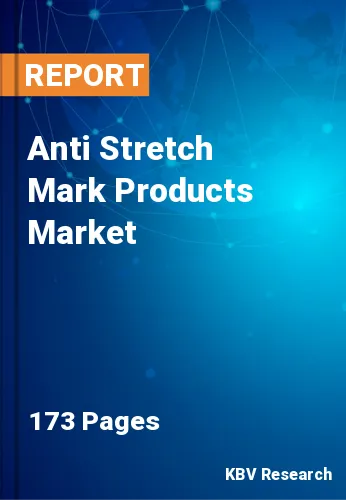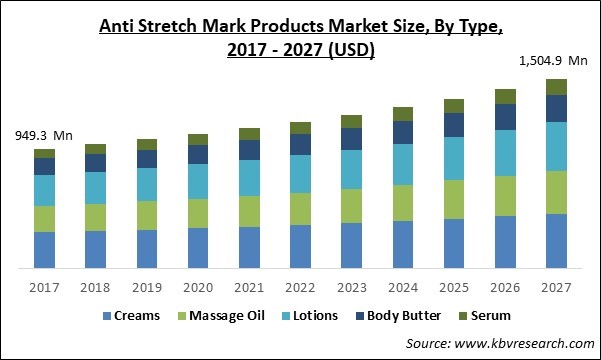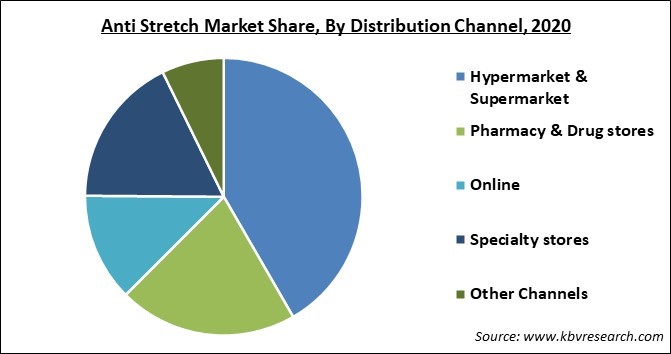
The Global Anti Stretch Mark Products Market size is expected to reach $1,504.93 million by 2027, rising at a market growth of 5.17% CAGR during the forecast period.
Stretch marks are kind of scars that occur on different parts of the body when the skin gets stretched or contracts easily. In addition, stretch marks are commonly observed in pregnant women and people having obesity. Generally, there are many treatments available in the market that would assist in the removal of different stretch marks. Additionally, obesity is one of the major causes of stretch marks. As per the World Health Organization, the number of obese people is tripled worldwide since 1975. Moreover, it also notes that there is a significant burden of obesity around the world, thereby increasing the number of people having stretch marks.
In addition, the demand for these products would be fueled by the growing consumption of calorie-laden fast food by a large number of people can bring stretch blemishes. Traditionally, anti-stretch skincare products were majorly available in the form of cream and lotion. Though, currently, numerous brands provide these products in several forms, including body butter, serum, and massage oil. In addition, a rising number of consumers are accepting these products, thereby driving market growth.

The outbreak of the COVID-19 pandemic has caused disruption for human lives as well as across many industries. The stringent lockdown restrictions and stay-at-home orders forced people to stay locked inside their homes. Moreover, manufacturing units were either completed closed or operating at a reduced capacity. As a result, this has created a big supply-demand gap in the market.
In addition, the global pandemic hampered the growth of the overall Anti-Stretch Mark Products Market because there was a drastic dip in the demand for beauty and skincare products around the world. Aspects like stay-at-home, social distancing norms, and stringent lockdown restrictions have majorly influenced the decision of the consumers to purchase skincare products including anti-stretch mark products as they have started to carefully spend on things to purchase only necessary and day-to-day routine products.
The increasing disposable income of individuals is playing a major role in the growth of the anti-stretch mark products market. As disposable income increases, the spending capacity of consumers also increases, thus fueling the sales of anti-stretch mark products. As per the U.S Federal Government, the GDPs of developing countries are increasing significantly in comparison to developed countries. Thus, growing economic conditions in the developing markets have fueled the disposable incomes of people.
Pregnant women are most vulnerable to developing stretch marks. Moreover, it has been seen that these pregnant women develop a tendency to remove these scars and marks soon after they give birth to the baby. This tendency is expected to boost the demand for anti-stretch mark products in the market. Moreover, the women are willing to purchase the best products for themselves in order to get rid of these marks as soon as possible. Considering this tendency, market players are launching many new products which are specifically designed for pregnant women.
Many companies in the market are launching customized products that cater to the needs of different skin types. Moreover, these substitutes are often cheaper than the popular products available in the market, thereby posing a big challenge to the growth & demand for such products. The companies offering substitutes have a presence on offline as well as an online mode which makes it easier for the consumers to purchase these products. Moreover, these companies are constantly launching unique products in order to maintain their competitive edge.

Based on Product, the Anti-Stretch Mark Products Market is segmented into Creams, Body Butter, Lotions, Serum, and Massage Oil. In 2020, the creams segment procured the maximum revenue share of the market and the segment would showcase a similar kind of trend even during the forecasting period. In addition, the majority of the consumers choose creams for stretch marks, spots, and blemishes with a rapid rate of product launch. Retinol (supports and resurfaces skin), Centella Asiatica (stimulates cell production), hyaluronic acid (plumps lines), and silicone are some of the beneficial ingredients found in these creams.
Based on Distribution Channel, the Anti-Stretch Mark Products Market is classified into Hypermarket & Supermarket, Pharmacy & Drug Stores, Specialty Store, Online, and Others. The hypermarket and supermarket segment acquired the maximum revenue share of the market in 2020. Due to the growing demand for skincare products and increasing shelf life, the majority of these stores have well-skilled workers in the skincare and beauty industry to offer required guidance and address the queries of the customers.
| Report Attribute | Details |
|---|---|
| Market size value in 2020 | USD 1,067.38 Million |
| Market size forecast in 2027 | USD 1,504.93 Million |
| Base Year | 2020 |
| Historical Period | 2017 to 2019 |
| Forecast Period | 2021 to 2027 |
| Revenue Growth Rate | CAGR of 5.17% from 2021 to 2027 |
| Number of Pages | 173 |
| Number of Tables | 299 |
| Report coverage | Market Trends, Revenue Estimation and Forecast, Segmentation Analysis, Regional and Country Breakdown, Companies Strategic Developments, Company Profiling |
| Segments covered | Product Type, Distribution Channel, Region |
| Country scope | US, Canada, Mexico, Germany, UK, France, Russia, Spain, Italy, China, Japan, India, South Korea, Singapore, Australia, Brazil, Argentina, UAE, Saudi Arabia, South Africa, Nigeria |
| Growth Drivers |
|
| Restraints |
|
Based on Region, the Anti-Stretch Mark Products Market is analyzed across North America, Europe, APAC, and LAMEA. In 2020, APAC emerged as the leading region in the overall Anti-Stretch Mark Products Market. Moreover, the region would showcase the fastest growth rate during the forecasting period. The growth of the regional market is attributed to the factors like rising consumption and adoption rate of the products, various global and local brands introducing products such as serums, lotions, and creams in the region, which would unlock growth prospects for the players operating in the regional market during the forecasting period.
Free Valuable Insights: Global Anti Stretch Mark Products Market size to reach USD 1,504.93 Million by 2027
The market research report covers the analysis of key stake holders of the market. Key companies profiled in the report include Beiersdorf AG, L'Oreal Group, Estee Lauder Companies, Inc., The Clorox Company, The Himalaya Drug Company (Himalaya Global Holdings Ltd.), Clarins Group SA, Earth Mama Organics, Crown Laboratories, Inc., and Mustela (Laboratoires Expanscience)
By Product Type
By Distribution Channel
By Geography
The global anti stretch mark products market size is expected to reach $1,504.93 million by 2027.
The increasing disposable income of individuals are driving the market in coming years, however, availability of cheaper substitutes have limited the growth of the market.
Beiersdorf AG, L'Oreal Group, Estee Lauder Companies, Inc., The Clorox Company, The Himalaya Drug Company (Himalaya Global Holdings Ltd.), Clarins Group SA, Earth Mama Organics, Crown Laboratories, Inc., and Mustela (Laboratoires Expanscience)
The expected CAGR of the anti stretch mark products market is 5.17% from 2021 to 2027.
The serum segment would showcase the fastest growth rate during the forecasting period. Over the years, there has been a sharp rise in the utilization of anti-stretch mark products around the world.
The Asia Pacific market dominated the Global Anti Stretch Mark Products Market by Region in 2020, and would continue to be a dominant market till 2027; thereby, achieving a market value of $649.8 Million by 2027.
Our team of dedicated experts can provide you with attractive expansion opportunities for your business.
